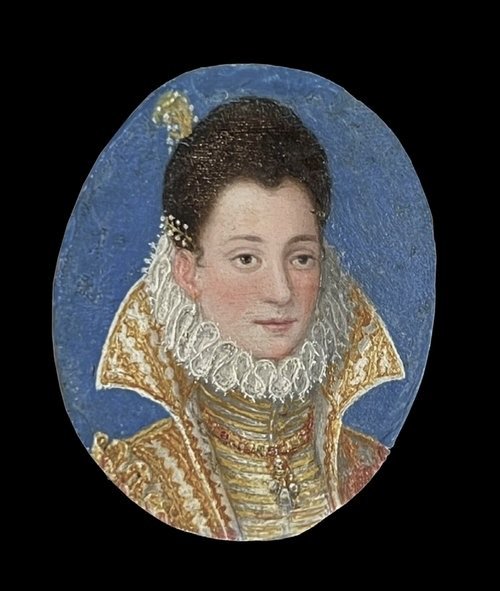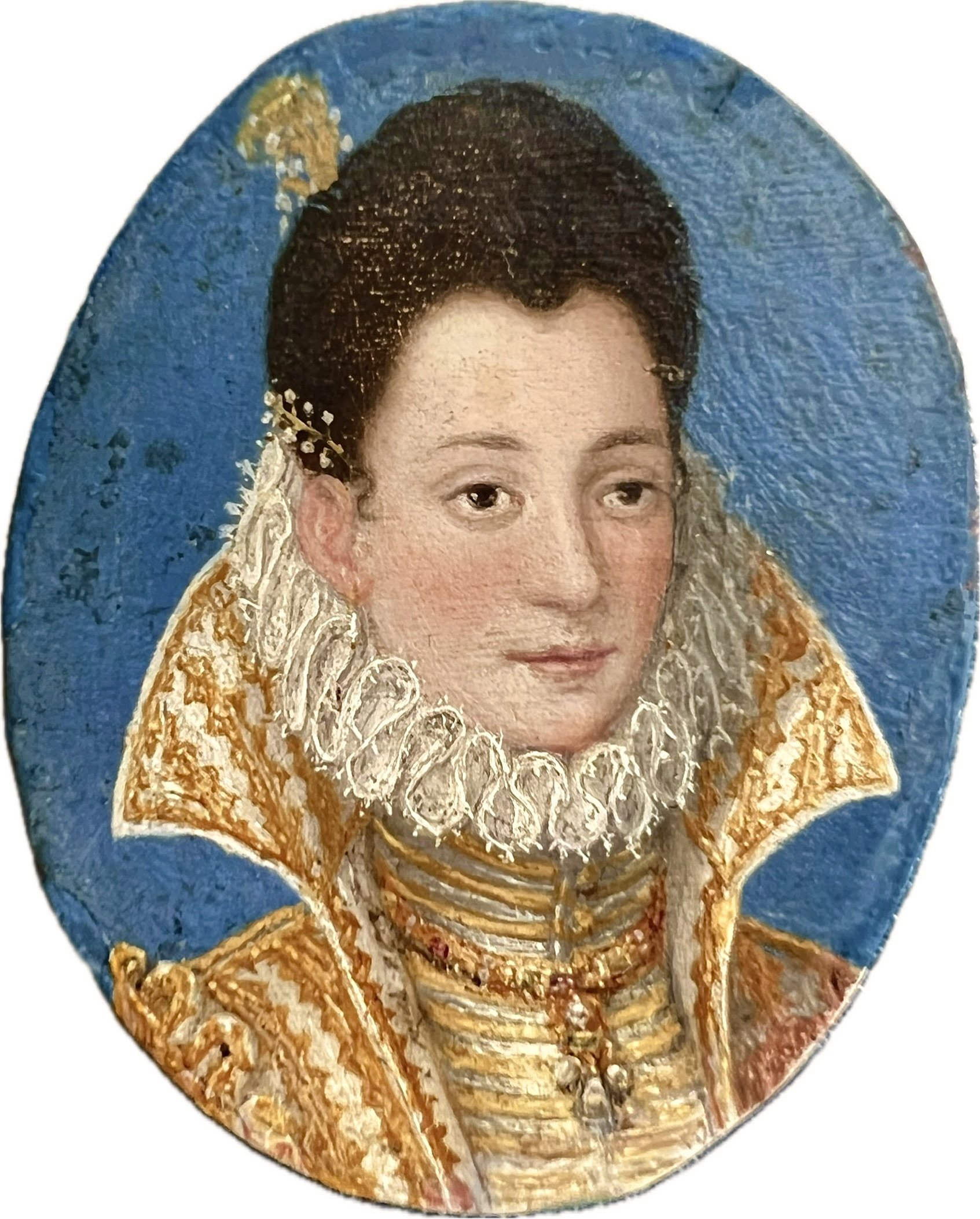
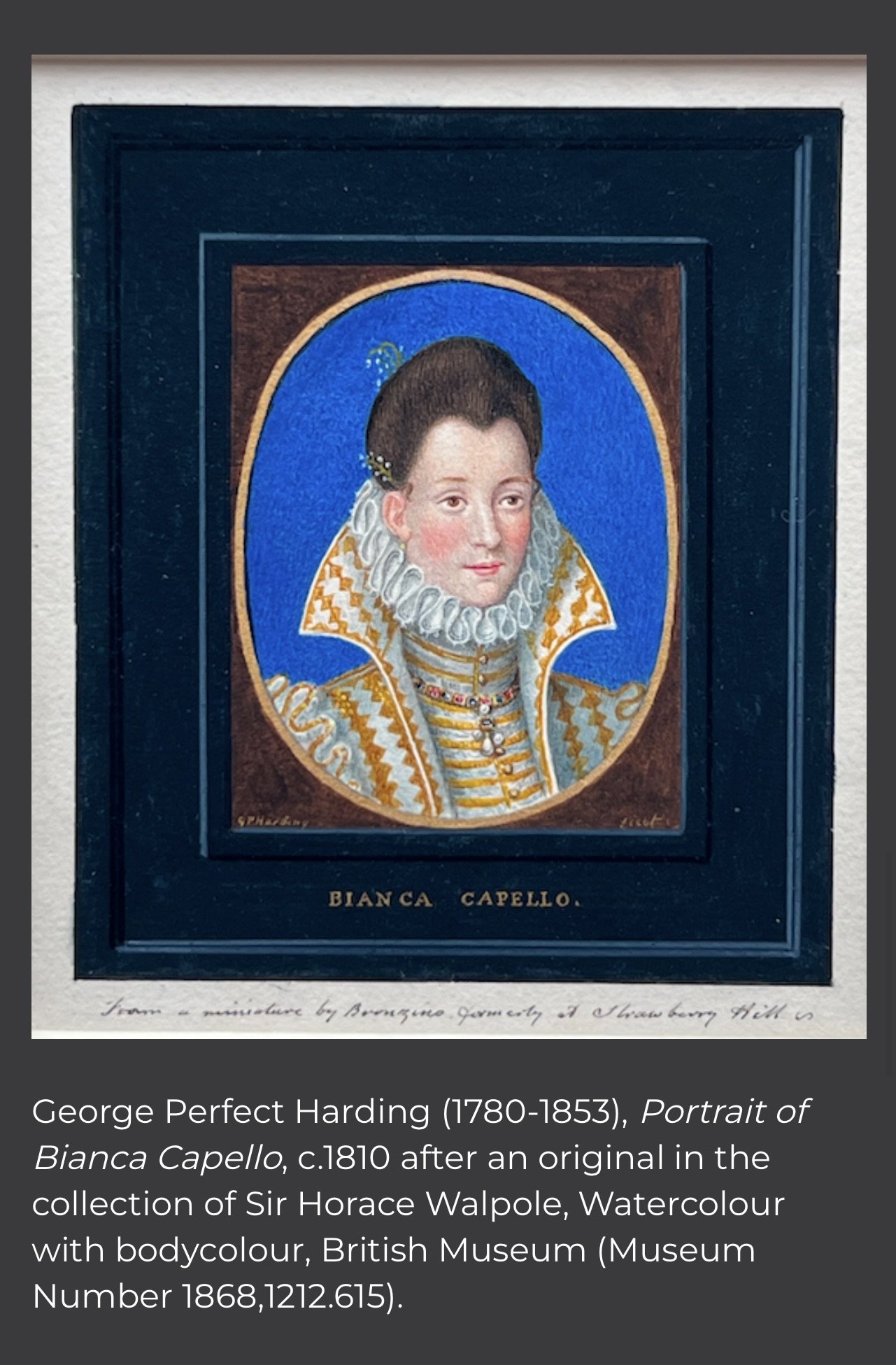



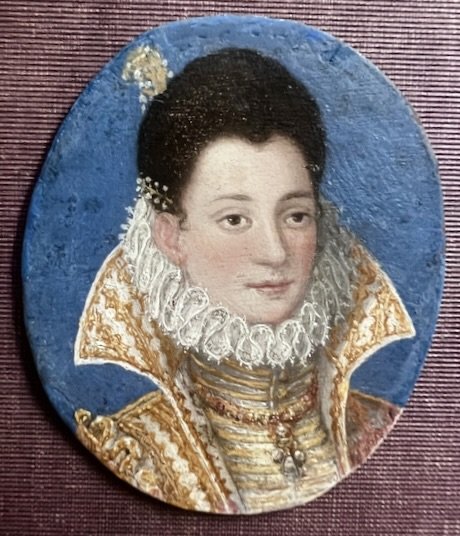
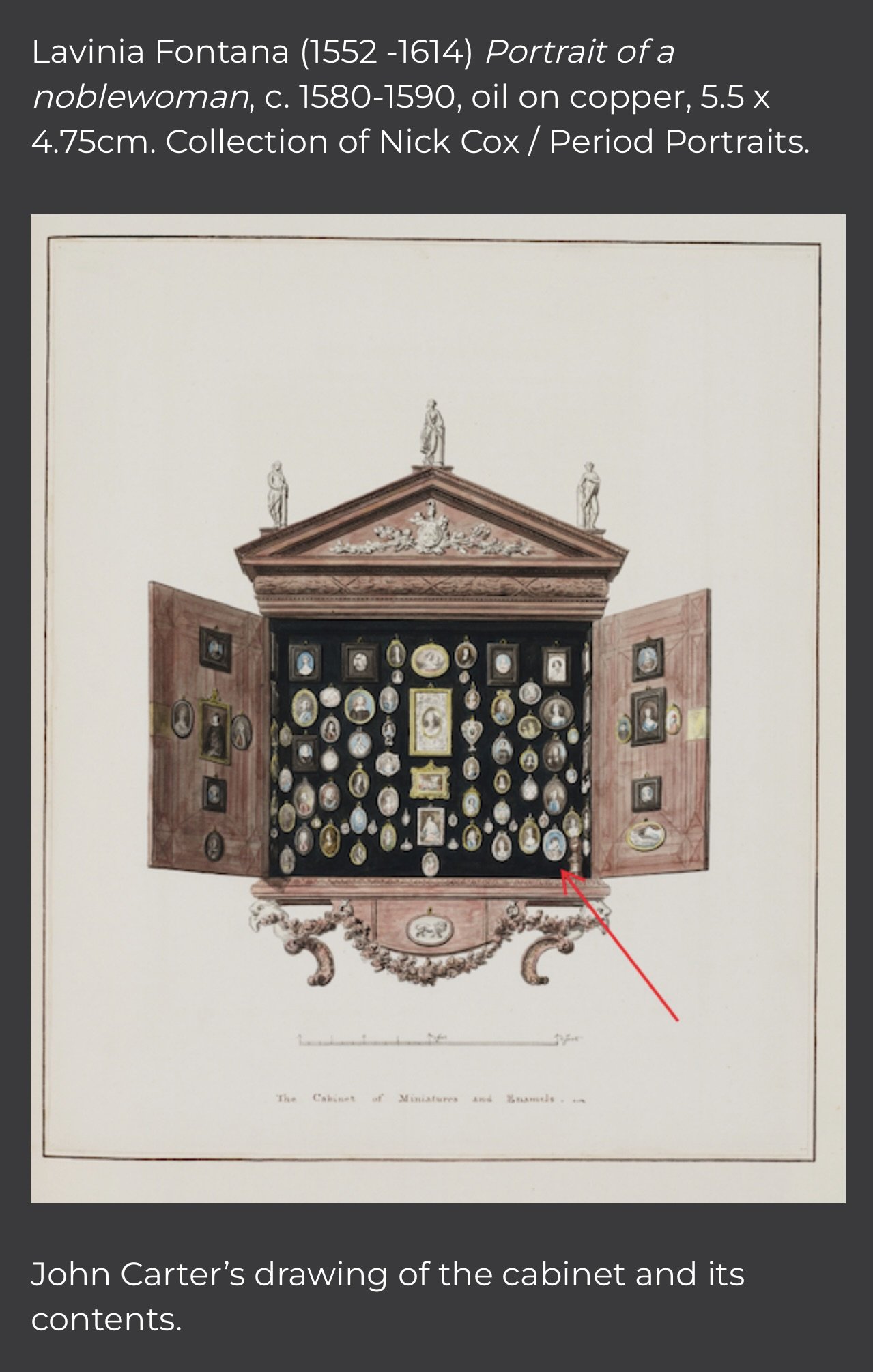


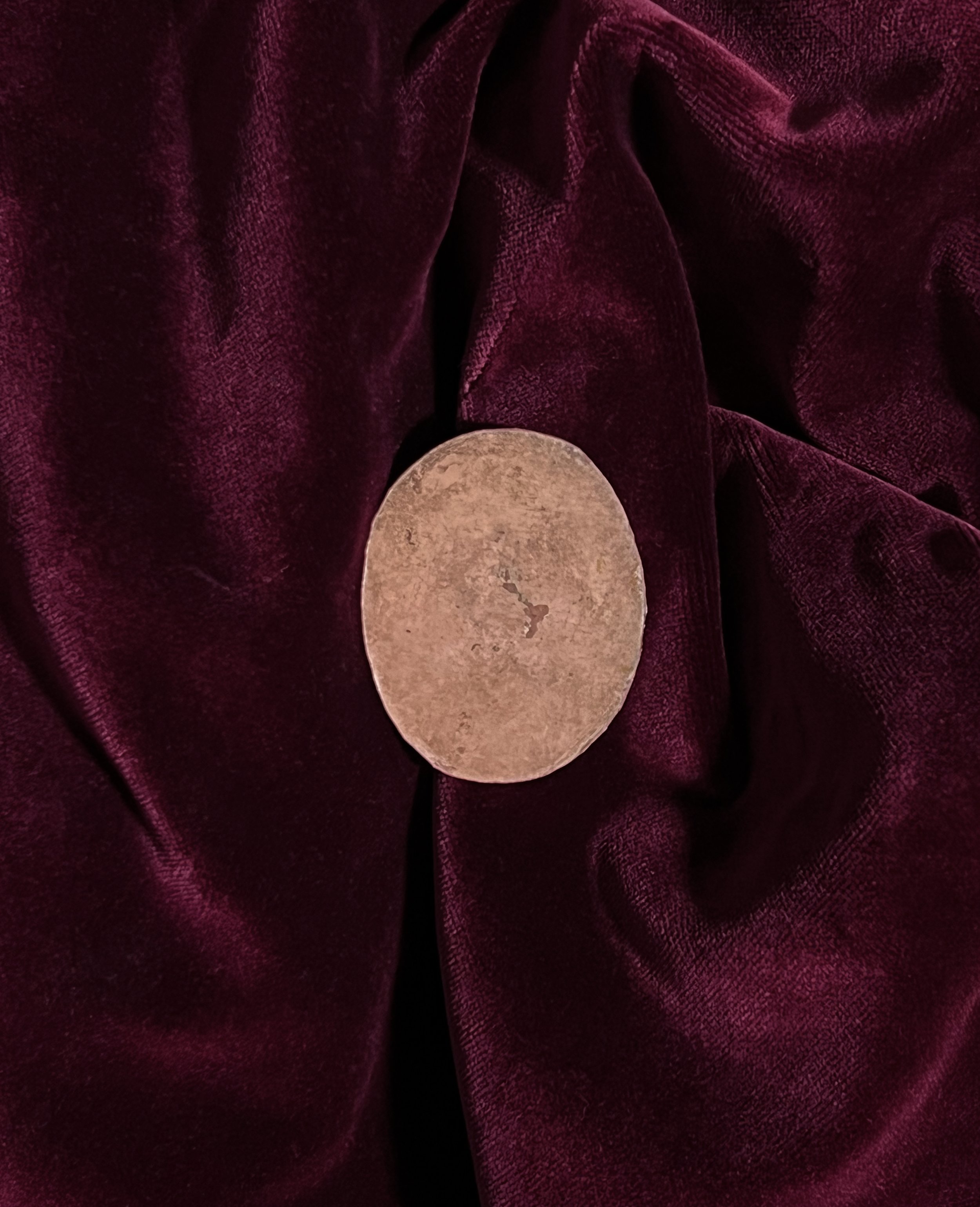
LAVINIA FONTANA (1552 -1614) - PORTRAIT OF A LADY OF THE MEDICI FAMILY.
Oil on copper miniature portrait of a young lady of the Medici family in court dress set against a lapis ground. The sitter wears an ivory-coloured dress and high-necked coat covered with raised gold embroidery and a closed ruff.
This fine miniature is a lost masterpiece from Horace Walpole’s celebrated collection and a 19th-century drawing led to its identification. At the time, the miniature was set in an elegant enamelled frame, as clearly shown in John Carter’s drawing of the cabinet and its contents.
John Carter, Disposition of the miniatures in the Rosewood Cabinet in the Tribune at Strawberry Hill, c. 1784, watercolour on paper, 32.6 x 27.5 cm, mounted, from Horace Walpole’s copy of ‘A Description of the Villa of Mr Horace Walpole […], c. 1784. The Lewis Walpole Library, Farmington, Yale University.
The cabinet itself is now part of the V&A collection. Designed by Horace Walpole in collaboration with William Kent, The Walpol miniature cabinet, 1873, Padouk veneered onto a pine carcase and set with carved ivory 11 plaques, figures and mounts, 152.4 x 91.5 x 21.6 cm, Victoria and Albert Museum, London, inv. W.52:1, 2-1925
The identification of the miniature was also confirmed by the existence of a copy of the work by the painter George Perfect Harding (1781-1853), who visited the collection in the early nineteenth century when Anne Seymour Damer occupied the house. Harding’s copy is now in the British Museum. George Perfect Harding, Portrait after a miniature once in Horace Walpole’s collection at Strawberry Hill, c. 1801-1853, watercolour on paper, 16.3 x 12.8 cm, British Museum, London, inv. 1868,1212.615.
The newly discovered artwork, a miniature once believed by Walpole to be by Bronzino depicting Bianca Capello, has now been attributed to the accomplished artist Lavinia Fontana (1552-1614). The scholar and V&A Curator Dr Adriana Cochin Tavella has successfully traced the history of the miniature and proposed that the exquisitely executed portrait most likely depicts a noblewoman from the Medici court, though her identity remains unconfirmed.
Walpole’s fascination with Capello even led him to coin the term “serendipity” while researching her Venetian coat of arms. This exquisite miniature, one of at least three portraits of Capello once displayed at Strawberry Hill, was discovered in a private collection and it is currently on loan to Strawberry Hill House.
This exquisite miniature portrait by Lavinia Fontana exhibits fashions consistent with the court of late sixteenth century Italy. At this time Italian fashions were heavily influenced by Spain, and the splendour and rigidity of such formal attire echoes this,with the lady’s upright deportment dictated by her high-necked garments.
Her stiffened jacket-like garment (not unlike a man’s doublet)appears to be made of cloth-of-silver, or perhaps white silk in a shiny satin weave. Strips of golden braid have been applied In horizontal bands over the surface of this garment, whichwould help to add structure and stiffen it, as well as creating therequired effect of conspicuous consumption as ‘these sitters knew that the most immediate way to convey their material wealth was through clothing’ 1
The high standing collar of the overgarment (called a ‘ropa’) is absolutely typical of the late 1500s/early 1600s. Braiding has been used to stiffen and structure this collar, as well as for decorative effect. The shoulder-seams are also braided. In our example the applied braids have serrated edges and the effect of verticality creates a pleasing contrast with the horizontal banding (often called ‘guarding’) of the bodice. A garment such as this would generally have pronounced shoulder wings and hanging sleeves (not visible).
The ruff in is closed (i.e. not open at the front) but is open set –which means that it has been arranged in figure-of-eights that have not been squashed flat together (closed-set) but each ‘set’ has been starched and set with a poking stick to create the open effect.
The sitters extensive jewellery consists of a gold and pearl hair ornament and a necklace composed of rubies and pearls, with a diamond centring the pendant.
LAVINIA FONTANA (born 1552, Bologna [Italy]—died August 11, 1614, Rome)Lavinia Fontana is the ‘first female artist to have had her own workshop’s
The Bolognese Mannerist school painter ran her own flourishing studios in Bologna, and then in Rome working on portrait commissions and also on religious paintings large-scale public altarpieces and on female nudes (at a time when women were notpermitted to study human anatomy.) She also worked for foreign nobility including the King of Spain and continued to paint throughout her eleven pregnancies. Fontana’s reputation was confirmed in her own lifetime when she was admitted into the illustrious guild for painters in Rome, the Accademia di San Luca, the first woman to achieve such an award. Lavinia Fontana is celebrated for both her use of luminous colour and her ability to render extraordinarily fine decorative detail in clothing and jewellery.
Here at the height of her career, in this miniature masterpiece,we see the artist’s skills distilled in their purest form.
1 Catalogue: Lavinia Fontana: Trailblazer, Rule Breaker. By Aoife Brady. Jonquil O’Reilly. p54
2 Catalogue: Lavinia Fontana: Trailblazer, Rule Breaker. By Aoife Brady, Aoife Brady p26
I am most grateful to Dr Aoife Brady viewing this work in person, and confirming authorship. And also to Maria Teresa Cantaro for viewing the work in person and stating that she also ‘locates this small painting at the height of Lavinia Fontana’s artistic career.’
This work is currently on loan to Strawberry Hill House in London where it is the subject of a stand alone exhibition ‘‘A Serendipitous Return: Lavinia Fontana’s lost Miniature' (25 January – 23 April 2025)
https://www.strawberryhillhouse.org.uk/lavinia-fontanas-lost-miniature/
Oil on copper Oval, 5.25 x 4.25cm.
Provenance The collection of Horace Walpole at Strawberry Hill House.
POA

